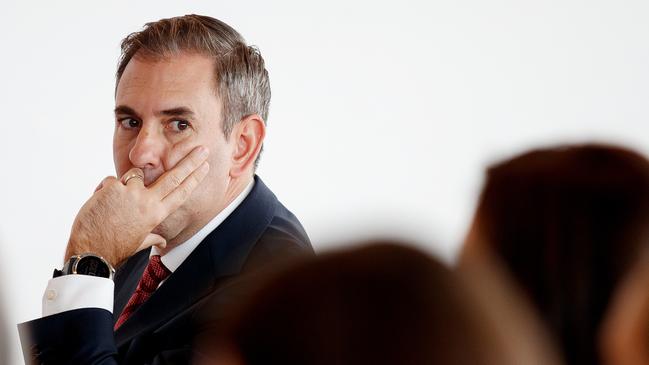Inflation rebounds in March quarter slashing odds of rate relief this year
With prices rebounding over the March quarter, investors and economists pushed out their timeline for rate cuts by the Reserve Bank.
Interest Rates
Don't miss out on the headlines from Interest Rates. Followed categories will be added to My News.
Investors and economists have slashed their bets that the Reserve Bank will deliver a rate cut this year, after inflation rebounded in the March quarter.
The consumer price index (CPI) rose 1 per cent in the first three months of 2024, the Australian Bureau of Statistics reported on Wednesday, up from 0.6 per cent in the December quarter, and well above the 0.8 per cent increase forecast by economists.
The quarterly result brought annual headline inflation to 3.6 per cent, with the reading benefiting from the removal of firm inflation figures from the 2023 March quarter when inflation rose 1.4 per cent.
Following the release, markets priced just a 19 per cent chance the RBA would deliver a rate cut at its final meeting this year, scheduled for December. On Tuesday, interest rate futures inferred an 80 per cent chance of a cut.
Economists at Citi, Westpac, UBS, AMP and RBC Capital Markets all deferred their rate cut forecasts following the CPI reading.
Speaking in Brisbane, Treasurer Jim Chalmers largely passed over the re-acceleration in quarterly inflation and instead focusing on the annual headline result, which remained below Treasury and RBA forecasts.
“That’s an important bit of perspective, I think people can get carried away, frankly, with the sorts of numbers that we’ve seen today,” Dr Chalmers told reporters.
“We know inflation is persistent, we know that it is lingering, but we are making welcome and encouraging progress.”
Also revealed in Wednesday’s report was a firmer than expected increase in trimmed mean inflation – the RBA’s preferred measure of prices which excludes more volatile items including food and energy – which climbed to 4 per cent in annual terms.
Prices for “non-tradables”, that is inflation driven by domestic factors, was also stubbornly high, sitting at 5 per cent in annual terms.
“Tradables” or imported inflation, was far softer, rising just 0.9 per cent in the previous 12 months.
Rate cuts face further delay
Jettisoning her forecast for a rate cut in September, Westpac chief economist and former RBA assistant governor Luci Ellis said the fresh inflation data was indicative of the “slow grind” in disinflation.
“We assess today’s release as implying a somewhat slower trajectory of disinflation than the RBA would like,” Dr Ellis said.
“Given the slower progress on disinflation this quarter and the lower starting point for labour market slack, we now expect the first rate cut to occur after the November meeting.”
EY chief economist Cherelle Murphy agreed that rate cuts were “not a done deal anytime soon” and cautioned that ongoing threats would make further declines in inflation challenging.
“New supply chain risks and rising oil prices from escalating tensions in the Middle East, ongoing strong demand for housing, and a tight labour market will continue to concern a Reserve Bank determined to get CPI back into the target band from mid-2025,” she said.

Little room for stimulus in May budget
With the federal budget less than three weeks away, HSBC chief economist Paul Bloxham said the government needed to ensure its spending didn’t exacerbate inflationary pressures.
“If the budget does deliver policy changes that add to demand, as we expect it will, it is likely that inflation will continue to fall only slowly and remain too high for the RBA’s inflation target,” Mr Bloxham said.
“Staying in the narrow pathway requires patience from both the RBA and fiscal policymakers.”
Shadow treasurer Angus Taylor seized on the firm inflation reading, arguing that it showed price pressures were “absolutely homegrown” and called for spending restraint from the federal government.
“The test for this Treasurer and this Prime Minister is to bring down a budget that goes to the source of the problem, that puts downward pressure on inflation and interest rates,” Mr Taylor said.
“That has to be the top priority.”

Insurance, education and rents drive inflation
The fresh inflation figures showed insurance premiums soared by 16.3 per cent, the strongest annual increase in 23 years, the ABS said.
With renters continuing to suffer from an acute housing shortage, an increase in rental prices also contributed to stronger-than-expected increase in headline inflation, rising 7.8 per cent in the year.
Had it not been for an increase in Commonwealth Rent Assistance in September, the annual increase would have been 9.5 per cent, the ABS said.
The data also showed a jump in education costs, up 5.2 per cent in 12 months, while medical services rose by 4.5 per cent over the same period.
But KPMG chief economist Brendan Rynne said the rise in health and education prices was unlikely to be replicated in coming quarters, with these components regularly rising in the March quarter.
“In effect they’re now out of the inflation equation until March 2025,” Dr Rynne said.
“The rest of the categories show an economy where prices are still growing but at a lower rate than recently, as a consequence of weakening aggregate demand.”
The RBA board will deliver its next interest rate decision on May 7 where it is widely expected to hold the cash rate steady.
Originally published as Inflation rebounds in March quarter slashing odds of rate relief this year




